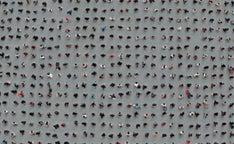My Project: Adam Magyar
The 37-year-old graphic designer turns 1,000 photos into one colossal composite.

“I used to do street photography,” Adam Magyar says, “but my photos always revolved more around a theory of urban space than a single image. And so it occurred to me to make that theory an image.”
Magyar’s ideas about urbanity are what inspired this project, Squares. What appears to be a crowd of street traffic on a very large plaza is in fact a composite: It’s a single image made up of all the pedestrians who cross a small chunk of sidewalk during three 2-hour photo shoots. Each of the nine completed images is an extremely highresolution, massive file.
Printed, they span nearly 6×10 feet. But the best way to view them is on Magyar’s website (www.magyaradam.com), where, by moving across the screen with your mouse, you can use the cursor to automatically zoom in on each of the individual figures, as if you were looking through a telescope.
The 37-year-old graphic designer was inspired to make the images based on his own observations of the density and anonymity of city life. He came up with it while planning another project, Urban Flow— which also combines multiple images of pedestrians, but into very long panoramas.
Though based in Berlin, he traveled across the globe to tackle the project. “To get the right distance and perspective for the images,” he says, “I needed to photograph from about 13 to 16 feet overhead, and the best locations for this are pedestrian overpasses that look down on sidewalks.”
In his travels, he’d found that these were much more common in Shanghai and Hong Kong, which is where the photographs for these images were taken. He is currently working on one shot in New York.
The sidewalks Magyar was looking down on had to be relatively litter-free, so that the surface area would be homogenous enough to stitch together later. He used Google Earth for research, then, having made a list of sites, he visited each to gauge street traffic: “There had to be not too few nor too many pedestrians,” he says.
Shooting with a Canon EOS 5D and either a 50mm or 100mm lens, Magyar spent about 2 hours shooting at each location. He arrived just before or after midday for consistency of light, and stationed a tripod on the overpass—first shooting from the apex and then from other perspectives on the left and right of the overpass.
He would return to a location several times (at the same time of day and in the same weather), until he had about 1,000 total usable images.
Then came compositing the image, a complicated process that required writing custom scripts to use in Adobe Photoshop. First, he wrote a script to create an entirely new background for the figures to stand on, one that was large enough and high-resolution enough to accommodate all the figures he wanted to include—at least 300 and sometimes over 400.
He separated multiple samples of bricks, and used his script “to randomly reorder them,” so that at no point were there any noticeable patterns other than the shape of the bricks themselves.
Once he’d assembled the background, Magyar wrote a second script to randomly reorder and position his figures across the new, huge background. Details such as the shadows of the figure are computer-generated and added later in 3-D software apps (he prefers not to say which ones).
“It was interesting to work on,” he says, “because when I look at the people walking in and out of the images, I think if I were one of these people I would be just a pedestrian, too.”